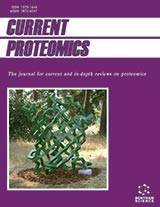Abstract
Protein structure and stability rely on the interplay of a large number of weak molecular interactions working in concert to assure a stable and unique native fold. Throughout evolution, different strategies have been devised to modulate protein conformational stability and enhance function and survival of proteins even under adverse conditions. The increasing number of characterized genomes and proteomes, especially those from thermophiles, provides a unique resource to study protein conformations at a wider scale. An integrated proteome-level perspective of protein conformational states in different cellular contexts is likely to contribute to a better understanding of functioning and control of biological systems. This review will address recent proteomic approaches, which allow screening and profiling proteins according to particular conformational features. We will discuss emerging methodologies that allow screening proteomes for unstructured or conformationally altered proteins, and novel approaches that profile and identify proteins within complete proteomes on the basis of their differential resistances to temperature, chemicals, or proteolysis. In particular, the profiling of proteins from thermophiles according to their thermostability will be highlighted as these studies may contribute to elicit general strategies accounting for protein stability and thermostable cellular processes.
Keywords: Protein folding, protein stability, thermostability, thermophiles, proteolysis, disordered proteins
Current Proteomics
Title: Conformational States and Protein Stability from a Proteomic Perspective
Volume: 4 Issue: 1
Author(s): Vesna Prosinecki, Patricia F.N. Faisca and Claudio M. Gomes
Affiliation:
Keywords: Protein folding, protein stability, thermostability, thermophiles, proteolysis, disordered proteins
Abstract: Protein structure and stability rely on the interplay of a large number of weak molecular interactions working in concert to assure a stable and unique native fold. Throughout evolution, different strategies have been devised to modulate protein conformational stability and enhance function and survival of proteins even under adverse conditions. The increasing number of characterized genomes and proteomes, especially those from thermophiles, provides a unique resource to study protein conformations at a wider scale. An integrated proteome-level perspective of protein conformational states in different cellular contexts is likely to contribute to a better understanding of functioning and control of biological systems. This review will address recent proteomic approaches, which allow screening and profiling proteins according to particular conformational features. We will discuss emerging methodologies that allow screening proteomes for unstructured or conformationally altered proteins, and novel approaches that profile and identify proteins within complete proteomes on the basis of their differential resistances to temperature, chemicals, or proteolysis. In particular, the profiling of proteins from thermophiles according to their thermostability will be highlighted as these studies may contribute to elicit general strategies accounting for protein stability and thermostable cellular processes.
Export Options
About this article
Cite this article as:
Vesna Prosinecki , Patricia F.N. Faisca and Claudio M. Gomes , Conformational States and Protein Stability from a Proteomic Perspective, Current Proteomics 2007; 4 (1) . https://dx.doi.org/10.2174/157016407781387375
| DOI https://dx.doi.org/10.2174/157016407781387375 |
Print ISSN 1570-1646 |
| Publisher Name Bentham Science Publisher |
Online ISSN 1875-6247 |
 13
13
- Author Guidelines
- Bentham Author Support Services (BASS)
- Graphical Abstracts
- Fabricating and Stating False Information
- Research Misconduct
- Post Publication Discussions and Corrections
- Publishing Ethics and Rectitude
- Increase Visibility of Your Article
- Archiving Policies
- Peer Review Workflow
- Order Your Article Before Print
- Promote Your Article
- Manuscript Transfer Facility
- Editorial Policies
- Allegations from Whistleblowers
Related Articles
-
ADAM10 as a Therapeutic Target for Cancer and Inflammation
Current Pharmaceutical Design The Changing Face of HIV/AIDS in Treated Patients
Current HIV Research Pathophysiology of IgG4-Related Disease
Current Immunology Reviews (Discontinued) Lipoprotein(a): Current Perspectives
Current Vascular Pharmacology Non Invasive Indexes for the Assessment of Patients with Non-alcoholic Fatty Liver Disease
Current Pharmaceutical Design Ferroptosis Inducers for Prostate Cancer Therapy
Current Medicinal Chemistry Evaluation of Brazilian Biotechnology Patent Activity from 1975 to 2010
Recent Patents on DNA & Gene Sequences Recent Advances of Fluorescent Technologies for Drug Discovery and Development
Current Pharmaceutical Design Assessment of Thyroid Disorders and Autoimmunity in Patients with Rheumatic Diseases
Endocrine, Metabolic & Immune Disorders - Drug Targets Somatic Drugs for Psychiatric Diseases: Aspirin or Simvastatin for Depression?
Current Neuropharmacology The Role of Kallikrein 7 in Tumorigenesis
Current Medicinal Chemistry Biologic Therapy in Inflammatory and Immunomediated Skin Diseases: Safety Profile
Current Drug Safety Polymorphisms of the Highly Expressed IL-6 Gene in the Papillary Thyroid Cancer Susceptibility Among Chinese
Current Molecular Medicine Noncovalent Binding to DNA: Still a Target in Developing Anticancer Agents
Current Medicinal Chemistry Reproductive and Endocrine Effects of p-Nonylphenol and Methoxychlor: A Review
Immunology, Endocrine & Metabolic Agents in Medicinal Chemistry (Discontinued) Pathway Analysis for Design of Promiscuous Drugs and Selective Drug Mixtures
Current Drug Discovery Technologies Role of Environmental Contaminants in the Etiology of Alzheimer’s Disease: A Review
Current Alzheimer Research Defining Pharmacokinetics for Individual Patient Dosimetry in Routine Radiopeptide and Radioimmunotherapy of Cancer: Australian Experience
Current Pharmaceutical Design A Stress Repair Mechanism That Maintains Vertebrate Structure During Stress
Cardiovascular & Hematological Disorders-Drug Targets Review of the Contribution of Radiolabelled Tracers for Tumour Cell Status Imaging
Current Medical Imaging























